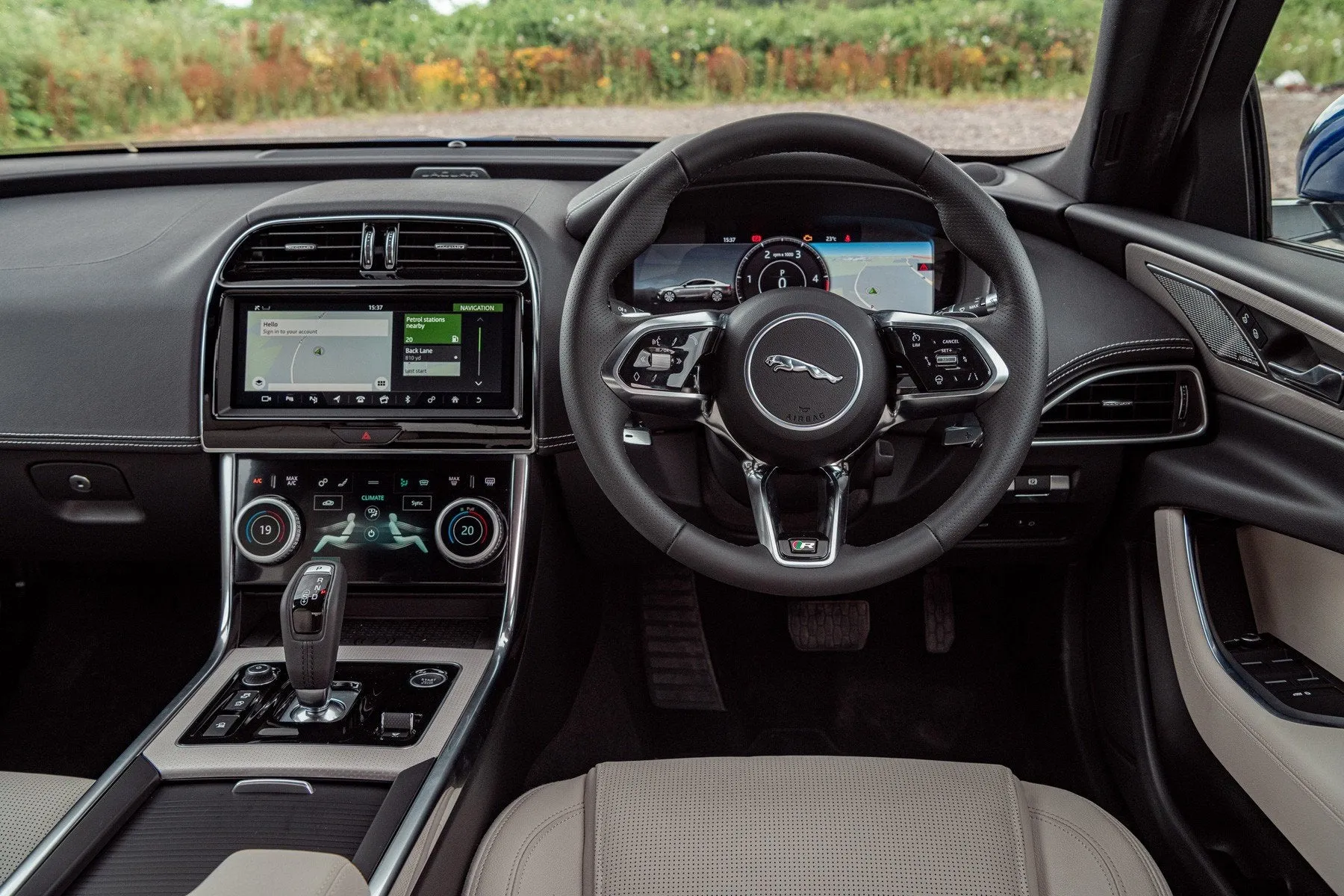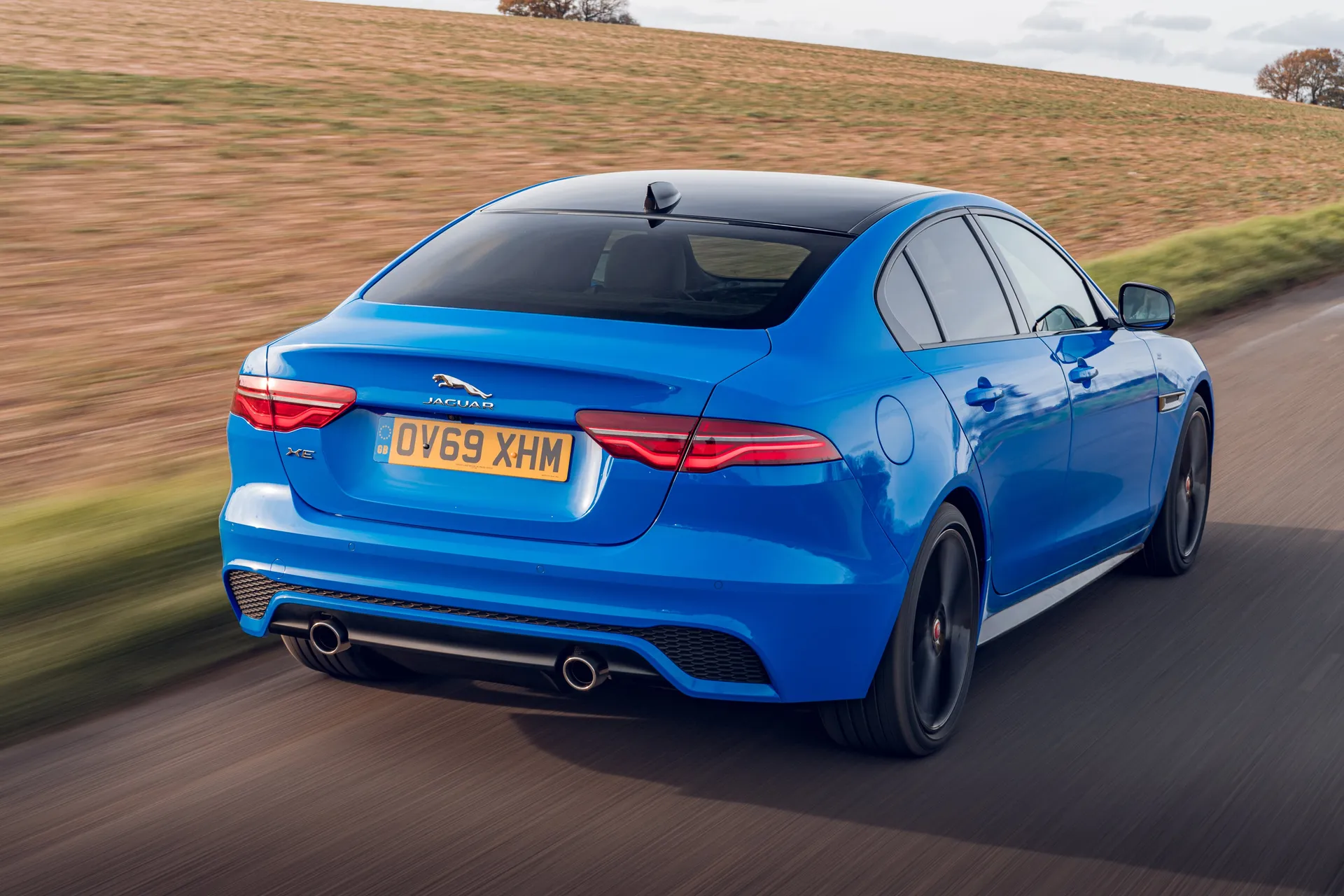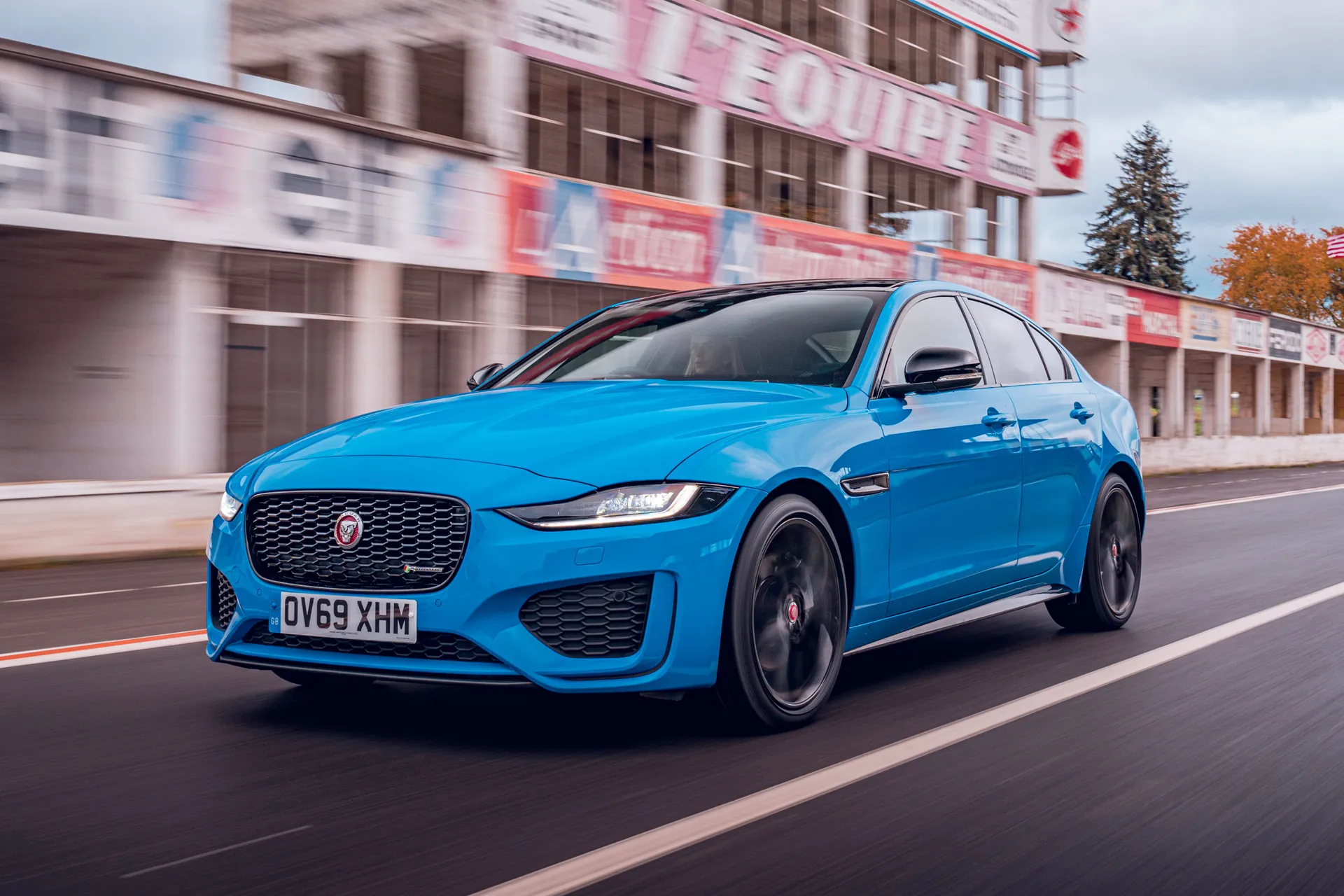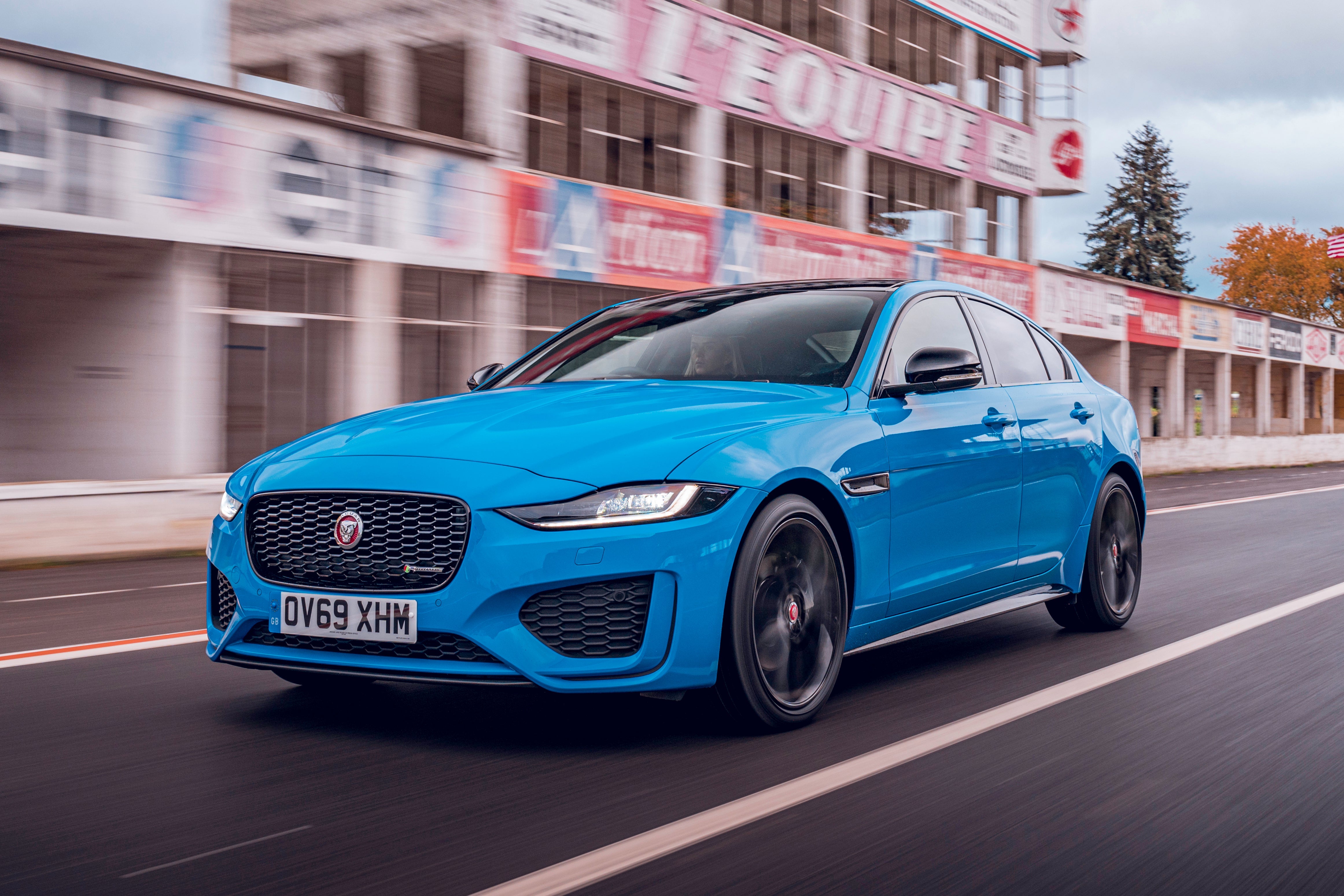Jaguar XE Review 2025: Price, specs & boot space
Written by Andrew Brady
Quick overview
Pros
- Fine looks, inside and out
- Excellent standard equipment levels
- Fantastic ride-and-handling balance
Cons
- No plug-in hybrid version
- Fiddly infotainment on early examples
- Rear seat space isn’t generous
Overall verdict on the Jaguar XE
"Ubiquity in the premium class goes in the Jaguar XE’s favour, as people looking for a sporty, enjoyable-to-drive alternative to the BMW 3 Series, Audi A4 and Mercedes C-Class are well served by Jaguar’s stylish XE. The marketplace might be dwindling overall, and Jaguar’s impact on overall sales within it are very marginal indeed, but the XE is a good choice if you dare to be different, and enjoy your driving."

The BMW 3 Series, Audi A4 and Mercedes-Benz C-Class might be the most obvious choices in the mid-sized executive saloon marketplace but, as you'll know if you're reading this Jaguar XE review, that trio aren’t the only contenders. Back in 2015 Jaguar added the XE, a new take on a smart, sporty and posh saloon, giving buyers bored of the usual suspects in this class something fresh and new to consider.
That was a long time ago, though, and the world has changed since. The traditional fleet-customer's volume heartland has been diminished in recent years through customers shifting from traditional saloons to SUVs, so the premium saloon's appeal isn't as strong as it once was. It's also true that the XE is properly getting on now: even the extensive 2019 facelift aimed at keeping the car fresh happened some years ago now. True, also, is the fact that the XE can't match rivals for breadth of choice when it comes to powertrains, with no plug-in hybrid option available, and neither is there a more practical estate version.
Among its rivals, the XE can also count a number of more mainstream brands with upmarket aspirations. Cars like the Volkswagen Passat, Volvo S60, Mazda 6 and more besides all offer alternatives, while the Tesla Model 3 offers an all-electric take on the premium saloon formula, and attracts the sort of global sales Jaguar can only dream of.
The XE might be a small-part player in the market it competes in, then, but it remains a relevant one, which underlines how impressive a job Jaguar had done with it when it was first revealed. Its relative rarity counts for it, and it's a choice that also comes without some of the negative stereotypes associated with its rivals. Add in, too, that the XE is still one of the finest cars in its class to drive, and it still has appeal.
That facelift in 2019 was successful, too, freshening up the XE’s looks, distancing it from its larger XF relation and giving it a sharper bolder look, particularly at the front. It also added more standard equipment and rationalised the engine line up.
A slight word of warning on that note, though, which will likely become an issue when choosing a used example. Throughout its many, many years on sale, Jaguar has changed its engine line-up and trim level offering on countless occasions, and researching the one you want can be a truly baffling business. Our advice? Just decide whether you want petrol or diesel, make sure to take a test drive to make sure it goes fast enough for your liking, and judge each used example you find on its own merits in terms of its equipment level and looks. Oh, and insist on a full service history. Always.
Whichever version you end up going with, though, you'll get a car that's enjoyable and satisfying to drive, with a mix of engagement and comfort that few cars can replicate, all wrapped up in a good-looking saloon-car package.
Looking for a used car for sale? We've got 100s of Jaguar Approved Used Cars for Sale for you to choose from, including a wide range of Jaguar XE models for sale.
Is the Jaguar XE right for you?
Bored of BMWs, and underwhelmed by Audis? Then the Jaguar XE might be just the thing.
Seriously, though, with the choice in this marketplace so dominated by that trio, the Jaguar XE really is a welcome additional choice for those buyers who might have run countless German saloons and want something - anything - a bit different, but that still wears an upmarket badge.
The BMW 3 Series has always been hailed as the driver’s choice in this marketplace, but even all these years on after its arrival, the XE still poses a serious challenge on that front, and it also does a superior job on ride comfort.
What’s the best Jaguar XE model/engine to choose?
As an all-rounder, the 180PS 2.0-litre turbodiesel a fine choice in the XE. It’ll return good economy and emissions, as well as decent performance, too. It was initially offered with a six-speed manual gearbox, but it wasn't too long before an eight-speed automatic became the only gearbox available. That's not hardship, because it's excellent. There are rear- or four-wheel drive options: rear-drive cars are more agile and get better economy, so go for one of those.
As for which of the trim levels to go for, you can't really go wrong because all of them - pre-facelift or post-facelift - come with a comparatively generous amount of luxury equipment as standard. If you can, we'd recommend a car from late 2020 onwards, as these have Jaguar's Pivi Pro infotainment system, which is a colossal improvement on earlier systems, which were rather convoluted and confusing.
What other cars are similar to the Jaguar XE?
We’ve covered that above, but it’s improbable that you’ll be looking at an XE without having the sporty BMW 3 Series, comfortable Audi A4 and luxurious Mercedes-Benz C-Class on your list, while there’s a good chance you might be considering a Volkswagen Passat or Volvo S60, too.
Comfort and design: Jaguar XE interior
"The interior of the XE has always provided a classy environment, but the changes in 2019 improved that further."

All XEs are fitted with leather seats, which offer 12-way electric adjustment as a minimum (top-spec trim adds four additional planes of electric adjustment, plus a memory function), and that amount of electrical adjustment is something you’d need to pay extra for with its key rivals. The seats’ range of movement means getting comfortable behind the wheel is very easy, and visibilty isn't too bad when compared with rivals, either.
The design inside is pleasingly simple and restrained, which means the interior’s aged very well. The makeup of the dashboard that faces you will depend on the age of your XE. Early cars got a basic touchscreen system that looked a little dated, but had physical buttons and knobs for controlling the ventilation system and other functions, and these worked well. Later on, these were replaced by a touch-sensitive panel. This looked better, but wasn't as easy to operate on the move.
Early XEs also had a disc-shaped gear selector for the automatic gearbox, which rose electrically out of the centre console when you started the car, and which you twisted to select drive. It worked well. Later on, this was replaced by an aviation-style lever selector, whereby you pull a trigger on the back of the lever and then pull it towards you to select drive. However, if you forget to pull the trigger - which you often do - the lever still moves but the drive isn't engaged. This leaves you going nowhere when you expect to have drive, and that can lead to various situations that are embarrassing, or alarming, or both.
Quality and finish
That timeless design has stood the XE in good stead when it comes to communicating a premium feel, but in early cars, it's also true that a few of the materials used inside didn't quite have the lustre or plushness as the equivalent ones found in German rivals: they were still good, just not quite as good.
The 2019 facelift improved things markedly, though, with the introduction of high quality materials throughout and a general sense of solidity and longevity that wasn't there before. It still doesn't feel quite as substantial and an Audi does, but at least it has the best matched for glitz and glamour.
Infotainment: Touchscreen, USB, nav and stereo in the Jaguar XE
All examples of the XF have a touchscreen infotainment system, but like everything else with the car, these changed periodically throughout the car's long life, so precisely which your car has will depend on its age and trim level.
Early cars got an 8.0-inch screen, which wasn't that easy to navigate and looked a little dated, but at least you got physical buttons and dials for operation the air-con, which was easier than the touch-sensitive panel they were later replaced with. Early cars also had analogue dials behind the steering wheel that were later replaced by digital instruments.
Bluetooth, DAB, navigation and voice control were all standard. It's also worth baring in mind that the XE was released before Apple CarPlay and Android Auto were really a thing, so the earliest examples won't have these functions, but they were introduced in a timely fashion once their use became widespread.
The 2019 facelift brought in the 10.0-inch Touch Pro infotainment system, which looked a bit better and was a bit easier to use, but it still trailed the best systems in the class for useability. In late 2020, JLR's Pivi Pro system was introduced, and this brought the XE's infotainment bang up to date. The glossy screen looks fab and works in a slick, glitch-free way, while the graphics are sharp and the screen responses are even sharper.
Space and practicality: Jaguar XE boot space
There's lots of space up front, but that’s not the case in the rear. Legroom and headroom are both fairly limited, with the XE trailing the surprisingly roomy BMW 3 Series in this respect. There are three seats in the back, but the middle one is very tight on space, while the raised cushion and the bulky transmission tunnel in the floor in front further limit its usefulness. That's something also true of all the XE’s rivals, but it’s more obvious with the Jaguar. A pair of ISOFIX mounts are fitted as standard to the outer rear seats, for securely fitting child seats.
Cabin storage is decent, with a pair of map pockets on the back of the front seats, a couple of good-sized cup holders between them, and a lidded cubby that doubles as an armrest. There’s a recess under the heating and ventilation controls that’s the perfect place to stow your phone. There are also door bins that are shallow, but able to hold a water bottle, while the rear doors offer small door bins, too.
Jaguar quotes the XE’s boot space using two figures, one being dry of 291 litres or wet at 410 litres. The first is the accepted VDA blocks method of measurement, the second being if the boot were to be entirely filled with liquid – as opposed to bottles of wine from a Waitrose shopping spree, then. Either way, that's considerably less than a BMW 3 Series, and the narrow access to it makes packing larger items like suitcases tricky. The seatbacks fold in a 40/20/40 configuration, to allow longer loads to be carried.
In terms of exterior dimensions, the Jaguar XE is 1410mm high, 4678mm long with 2075mm wide (including door mirrors).
Handling and ride quality: What is the Jaguar XE like to drive?
"The BMW 3 Series has long been the benchmark in this class in relation to ride and handling, but the Jaguar XE gave it some serious competition."

That remains true today, even though the XE’s foe has been renewed in the time that the Jaguar has been on sale. The XE still strikes a brilliant balance between ride comfort and engaging, enjoyable handling.
Like the BMW and Mercedes-Benz C-Class, it’s rear-wheel drive, with some models gaining four-wheel drive (but retaining a rear-wheel bias), and the chassis’ balance is obvious as soon as you get underway. That's helped by well-weighted steering and a quick, faithful turn-in, which help make the XE feel even more agile. Thankfully, though, the quickness of the steering doesn’t translate to a busy, tiring experience on the motorway. The enjoyment remains regardless of which model you specify.
There are variables in how the various versions drive across the range, but it’s to Jaguar’s credit that the differences are so slight. Four-wheel drive versions lack a little bit of the crisp steering of the rear-wheel drive versions, but the difference is very marginal, while R-Dynamic S models, which add sports suspension (on rear-wheel drive models only) and larger alloys, hardly suffer any loss in the suppleness of the ride. It’s so good as standard, in fact, that we wouldn't bother finding a car with the optional Adaptive Dynamics system, which adds variable damping, because it doesn't add enough to the ride and handling mix to justify your time and money.
What engines and gearboxes are available in the Jaguar XE?
We've said a few times already that the XE has undergone many significant changes over its long life cycle, and nowhere is this more evident that with its engine range.
When the car was first released, it had the added fanfare of Jaguar Land Rover's brand new lineup of Ingenium four-cylinder petrol and diesel engines. These were initially petrols with 200PS and 240PS, and diesels with 163PS and 180PS. A 340PS 3.0-litre supercharged V6 petrol was shoehorned into the standalone high-performance S variant, meanwhile.
The vast majority of early cars had diesel engines, as was the fashion of the time. The lower-powered 163PS unit delivered adequate performance, but the 180PS delivered a bigger uptick in performance than the numbers suggested, and it felt a lot brawnier and a lot more relaxed as a result. It was smooth, too, and although it was rather noisy in the early days, Jaguar kept working on it as time went on and improved things on that score. Early cars also had the option of a six-speed manual gearbox, but it wasn't too long before the eight-speed automatic became the sole gearbox offering. It does a good job in most situations, but it can get a little bit flustered if you’re in a hurry.
In 2017, the 240PS petrol was upped to 250PS, and a new 240PS version of the diesel was introduced. The V6 is the S, meanwhile, was given another 40PS, taking it up to 380PS. Later that year, a 300PS version of the four-cylinder petrol was introduced, and the bonkers XE SV Project 8 was revealed. This was a limited run of 300 cars packing supercharged 5.0-litre V8 petrol engines and four-wheel drive. With 600PS, these could blast from 0-60mph in 3.3 seconds.
With the 2019 facelift came more change. The changes to the engines themselves were minor, but the way in which they were named changed completely. Each was prefixed by a P or a D, identifying which flavour of fuel it favoured, followed by its approximate output in metric horsepower. The options were pared back, though, with only the P250, P300 and D180 being offered. More updates the following year saw the diesel's output jump up to 204PS (it became the D200 as a result), thanks partly to the addition of mild-hybrid technology.
The performance of the diesel was largely unchanged, and will still be the pick of the range for most. The petrol pairing is good, too, with the P250 being rear-wheel drive, and the P300 being all-wheel drive. The P250 is the pick, not just because the driving experience is purer thanks to its rear-wheel drive layout, but also because it feels like its over-delivering on performance given its output. It’ll reach 62mph in 6.5 seconds, the P300 taking 5.7 seconds, and both are smooth and responsive, with plenty mid-range power and an enthusiasm for revs.
Refinement and noise levels
The XE’s refinement is good all-round with wind- and road noise nicely contained at all speeds, while the engines are hushed unless you’re really pushing them. The diesel isn’t quite as quiet as those in the Audi A4 line-up or the BMW 3 Series, even after improvements in that area over time, but the difference is only very slight, and what noise they make isn’t actually unpleasant. There’s a bit of vibration through the drivetrain with the diesels, but, again, we’re being exceptionally picky here, and for the most part you won't even notice it.
Safety equipment: How safe is the Jaguar XE?
Crash tested in 2017, the Jaguar XE scored a maximum five-star score in Euro NCAP crash tests, and while those standards have gotten tougher to incorporate mode driver aids, the Jaguar will undoubtedly protect you well should an accident be unavoidable. There’s plenty of standard equipment fitted to try and prevent an accident happening in the first place, with traction and stability control, ABS with Emergency Braking, Lane Keeping Assist and Driver Condition Monitor, front and rear parking sensors, a rear camera and Traffic Sign Recognition and Adaptive Speed Limiter. There’s tyre pressure and brake pad wear sensors, ISOFIX child seat mounts on the outer rear seats, a front, side and curtain airbags.
MPG and fuel costs: What does a Jaguar XE cost to run?
"The Jaguar XE D180 will be the most economical XE of recent years to buy and run. Its economy, measured by the WLTP testing regime, is rated at 46-51mpg on the combined consumption cycle."

Pick that same engine with four-wheel drive and consumption increases to 41-46mpg, which is still around 10mpg better than the petrol choices get on the same consumption tests.
How reliable is a Jaguar XE?
Jaguar has a better reliability than its sister brand Land Rover, but that's not saying much: the British-based 4x4 specialist perpetually languishes at the bottom of the pile in most of the various reliability surveys doing the rounds. Indeed, Jaguar was named on the list of the 10 least reliable brands in the 2023 HonestJohn.co.uk Satisfaction Index, although it was named in 10th spot, so it could've been worse. More positively, tha brand placed 5th out of the 29 manufacturers consider for overall satisfaction, so owners appear to be very happy with their cars in other ways.
Look at the Jaguar XE review on HonestJohn.co.uk (our sister website), meanwhile, and you'll find reams of reports from owners about issues they've had with their cars.
Insurance groups and costs
Insurance groupings for the Jaguar XE drop as low as 22 for the early diesels, and climb as high as 50 (the highest you can get) for the Project 8, but the likelihood of you buying either one of those for sale is pretty marginal. The D180, D200, P250 and P300 models all sit in the late twenties and early 30s when it comes to groupings, which makes the Jaguar XE is competitive across its range in comparison to its German rivals.
VED car tax: What is the annual road tax on a Jaguar XE?
Buy a diesel-powered XE built before March 31st 2017, and you could save a bundle in tax. Some of them had low enough CO2 emissions that you pay nothing at all, and many others qualified for an annual rate of just £20 or £30. The petrols were a sight steeper though, so be very careful. It's always a good idea to perform an online check with the registration mark of any used example you're considering before buying, so that you know exactly what you're letting yourself in for.
Buy a car built after that date, and you'll be charged the same flat rate that applies to all petrol and diesel cars. This rate currently stands at £190 per year. The D200 diesel's mild-hybrid technology with earn it a £10 discount each year, though.
However, that's not the end of the story, because cars that cost more that £40,000 when brand new, including optional extras, are liable for a 'luxury car surcharge' that applies for a temporary five-year period between years two and six of the car's life. That surcharge currently stands at £390, paid on top of the regular annual rate.
The pricing of some versions sits above that threshold, and although lots sit below, some get quite close, so the addition of a few optional extras - of which the choice is plentiful - could take the sum over the limit. As before, an online check with the registration of any used car you're considering is always a good idea.
How much should you be paying for a used Jaguar XE?
"The very earliest XEs won't feature in heycar listings, because the cars for sale on our site can be a maximum of eight years old, but there are still some proper bargains to be had."

Most of the cheapest cars you'll find will be 180PS diesel models, as these were by far and away the most popular versions. These can be had from around the £11,000 mark, in a variety of trim levels, but these will be relatively old cars with fairly punchy mileages of between 60,000 and 80,000 miles.
For a car from after the 2019 facelift, you're looking at more like £19,000 or £20,000, and these will be a fairly even mix of petrol and diesel. Nearly new cars of less than a year old with a four-figure mileage can be had for around £30,000 if they're in a modest enough spec.
Trim levels and standard equipment
As we've said a number of times already, the XE went through numerous changes throughout its time on sale, and that very much applies to the trim levels offered, and the amount of equipment that was provided with each. As such, researching which trim came with what at any given time can be very baffling, but there is one notion that simplifies it all. Basically, all trim levels at all times were very generously equipped, especially in comparison to the notoriously stingy German rivals. So, whatever car you go for, you won't be slumming it or going without, so simply find a used version you like the look of, make sure it's got any deal-breaking features that you simply must have, and anything else you get is a bonus.
Initially, trims included SE, Prestige, R-Sport, Portfolio and S. All had cruise control, leather upholstery, automatic lights and wipers, alloy wheels, rear parking sensors, and an extensive suite of infotainment and safety kit. Equipment levels ramped up significantly and you progressed through the trim grades, and the top-spec versions were properly tooled-up.
Later, you chose between S and R-Dynamic models, the former having quite restrained styling and the latter adding lots of racy styling touches and a sports suspension. To those, you then added S, SE or HSE trim levels, which provided and increasing amount of luxury kit. Again, all come with everything you need, and HSE version coming with just about every creature comfort you can think of.
The S version was later discontinued, leaving only the R-Dynamic specification. The exception is the XE fitted with the 300PS petrol engine which comes in its own standalone Sport trim.
Ask the heycar experts: common questions
Is the Jaguar XE reliable?
Is the Jaguar XE better than the Jaguar XF?
Is the Jaguar XE worth buying?
Get our latest advice, news and offers
Keep me updated by email with the latest advice, news and offers from heycar.
By submitting you agree to our privacy policy



